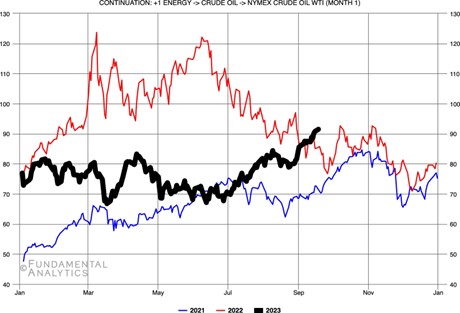Dr. Ken Rietz
September 20, 2023
For many years now, the price of gasoline in the US has been lower than the price of diesel fuel, but that hasn’t always been the case. They were reversed consistently for a decade ending in September of 2004. But EIA projections show the price of diesel fuel now increasing faster than the price of gasoline in the near term. The reasons are complicated. Let’s examine this situation more closely. We start with the price of WTI crude oil, the raw material for diesel fuel.

Figure 1: Front month futures price of WTI Crude Oil, dollars per barrel, NYMEX Exchange
You can tell from the graph that the price of crude oil is on an uptrend (with spikes corresponding to the Russian invasion of Ukraine), which is likely to continue as long as Saudi Arabia and Russia are reducing their crude oil exports. Bloomberg says that $100 per barrel of crude oil is “back in sight.” Goldman Sachs expects $100 per barrel by the end of the year. But that is only part of the story; the cost of diesel and gasoline would increase at the same percentage rate if an increase in the cost of the supply were all that drove the cost of diesel. We need to look for other factors.
There are three other major factors in the cost of the production of diesel fuel we need to look at. The refining process would favor diesel fuel over gasoline. Both diesel and gasoline are, at the molecular level, chains of carbon atoms with attached hydrogen atoms. Gasoline has shorter chains, which has the effect of making it more reactive, and therefore more sensitive to refining and harder to produce. The cost of refining diesel is lower. This isn’t helping our quest. Another factor is the tax rate on diesel, which is quite a bit higher, enough to overcome the difference due to refining. The reason for the difference in tax rates is that the tax ends up funding road building and repair, and trucks are harder on roads than cars. The other major factor is the efficiency of the refining process. A 42-gallon barrel of crude oil will produce 11 to 12 gallons of diesel, or if turned into gasoline, would produce 19 to 20 gallons. Now that is a significant difference. Refiners have to balance how much crude oil to change into gasoline, and how much to use to create diesel.
The cost of supply is only half the story, though. We must take into account demand. In early June of 2023, the EIA said “[w]e expect this [downward] trend to continue; we forecast in our STEO [Short-Term Energy Outlook] that U.S. diesel consumption in the second half of 2023 will be below the 2015–2019 average before a slight further decline in 2024 despite an expected increase in GDP over the same periods.” But a decrease in demand would normally imply a lower price. Except it is more complicated. When demand drops, refiners don’t produce as much diesel, and produce more gasoline (or other distillates) instead. The price of diesel then actually increases because economies of scale now work against it, and the price of gasoline would decrease for the same reason.
The summary of these facts produces a somewhat grim picture for diesel fuel in the short term. The demand will drop fairly slowly, but the price will increase gradually at the same time. Since most trucks and trains use diesel fuel, with no cheaper alternative available, just about everything sold in stores will become more expensive, which is good for the GDP, but not for inflation.